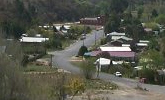| Gold was discovered in the
Captain's Flat area in 1864. It wasn't until 1882 that
a large productive reef was discovered on a ridge above
Captain's Flat township by Hugh McNeill, William
Harkness and Edward Holehan. The Molonglo River
Goldfields were proclaimed on 27 September 1882, which
started the Molonglo River goldrush. The McNeill claim
was at the northern end of the ridge and Ralph
Montgomery took a seven acre lease adjacent. George
Emmerson struck gold further south which became known as
the "Coffee Claim", due to the nature of the ore.
In 1883, a Mr Blatchford erected a 20 head stamping
mill where Emmerson trucked his ore for crushing.
Bernard Holtermann MP, bought a half share of McNeill's
mine and built a 10 head stamping mill.
The Blatchford mine yielded some 360 ounces of gold
from 2,386 tons of quartz. Gold was difficult to extract
from Captain's Flat ore due to the high levels of silver
and lead. Montgomery's mine yielded 240 ounces of gold
from 800 tons of ore.
In 1885 Holtermann died which stalled the northern
mines, water was in short supply and gold yields dipped.
However the mines perservered and attention turned to
the lead and silver which had proved so detrimental to
the gold extraction.
In 1885, Blatchford built a Kahlo and Dobb "Pacific
Water-jacket Smelter. This revolutionised the mines and
only large scale operators could survive. Blatchford
formed a company and named his mine El Capitan with
Montgomery doing the same some six months later. His
claim became the Koh-i-noor Mine. At this time, lead was
the most important mineral.
The mines of Captain's Flat sent some 182 tons of ore
to Swansea in Wales, this being comprised of 176 tons of
lead, 52,775 ounces of silver and 427 ounces of gold.
The Vanderbilt mine was opened by William Garland on the
eastern side of the town and this became the North
Vanderbilt Amalgamated Silver Mining Company Limited.
This venture was not successful and was abandoned after
two years. El Capitan mine was taken over by the Broken
Hill Propriety and renamed the Commodore.
Two new furnaces at Commodore, one at Koh-i-noor, a
stamping battery, Huntingdon Mill and a reverberatory
calciner still failed to successfully extract the metals
from the Captains Flat ore. The Koh-i-noor began heap
roasting the ore in 1890, workers heaping the ore onto
timber beds which were then set alight. Huge amounts of
sulphur were released which killed most of the bushland
in the area, which in turn was felled and used in the
furnaces.
Finally in 1894, the Commodore-Vanderbilt and
Koh-i-noor mines were amalgamated and became the Lake
George Mining and Smelting Company. After British
investment in 18996, the name was shortened to Lake
George Mines Limited with Mr. Trewenack as general
manager.
By introducing Pyritic Smelting, the company believed
they could increase yields and set about building
stacks, furnaces and installing pumping equipment,
electric lighting and telephone communications.
A tram line was built to dispose of waste materials.
The smelter, built on the southern edge of the town
between the Molonglo River and Jerangle Road, spewed
smoke and soot every hour of the day and night and the
red hot slag looked like lava as it oozed down the
slopes.
The mines yielded 860,795 ounces of silver, 3,781
tons of copper and 16,140 ounces of gold from 205,707
tons of ore, between 1887 and 1899. The vast copper
yields made world headlines and attracted great
interest, seemingly assuring Captain's Flat as a major
industrial centre. |
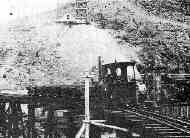
Tramway across the ravine near the Commodore Mine which
is visible in the background (circa 1896). This area
renamed Keatings later collapsed. Ruins of this tramway
still remain on both sides of the ravine.
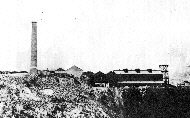
The smelter in 1896
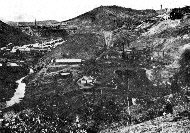
Looking south at Captain's Flat Koh-i-noor Mine at top
right with the smelter site at top left (circa 1896)
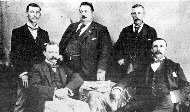
Original management members of Lake George Mines
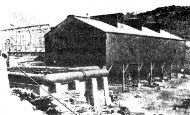
Hot air pipes and ore feeder shaft in 1897 |
